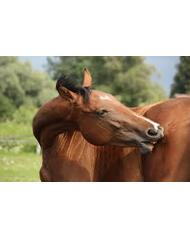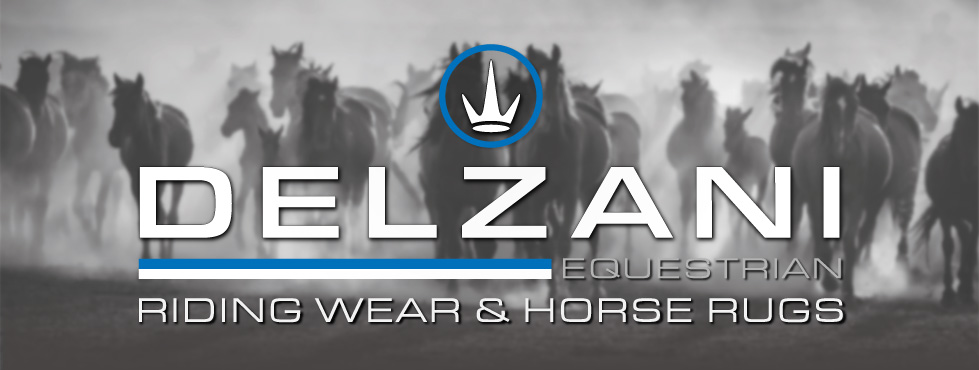Managing and Preventing Queensland Itch in Horses

Managing Queensland Itch in Horses: Causes, Symptoms, and Proven Prevention Tips
Updated September 2025
A practical guide for Australian horse owners on recognising, managing, and preventing Queensland Itch - with real-world advice on fly protection, skin care, and long-term comfort.
Every Australian horse owner knows how heartbreaking it is to see a horse scratching raw patches of skin, rubbing on posts, and looking miserable through summer. This is more than a simple irritation - it’s Queensland Itch, also known as Sweet Itch or Summer Itch - an allergic reaction that can make life unbearable for horses during warm, humid months.
At Delzani, we care about keeping your horse comfortable and thriving year-round. This guide explains what Queensland Itch is, what causes it, how to treat and prevent it, and how the right fly masks and fly mesh rugs can make a real difference.
What Is Queensland Itch?
Queensland Itch, also known as Sweet Itch or Summer Itch, is an allergic skin condition in horses caused by the saliva of tiny biting midges (Culicoides). These insects feed at dawn and dusk, and when they bite a sensitive horse, the immune system overreacts. The result is relentless itching, hair loss, and skin inflammation that can quickly spiral into raw, painful patches if left untreated.
The condition is most common in Queensland, New South Wales, and Northern Australia, where warm, humid weather and still water create the perfect breeding ground for midges. Horses grazing near creeks, dams, or long grass are at the highest risk, especially during the summer wet season.
What Causes Queensland Itch in Horses?
- Midge bites: The allergic response comes from proteins in the saliva of Culicoides midges.
- Climate: Warm, humid environments create ideal breeding conditions for midges.
- Genetic sensitivity: Some horses are more prone than others, especially dark-skinned breeds like bays and greys.
- Prolonged exposure: Horses exposed to midges for long periods without protection are more likely to develop hypersensitivity.
Common Symptoms of Queensland Itch
Early detection is key. Signs your horse may be suffering include:
- Constant rubbing of mane, tail, face, and belly.
- Hair loss, broken skin, and scabbing.
- Thickened, folded, or pigmented skin from chronic irritation.
- Agitation, poor coat condition, and reduced performance.
How to Treat Queensland Itch in Horses
The goal is to stop the midges from biting, soothe existing irritation, and reduce allergic reactions. Here’s how to take a multi-step approach that really works.
1. Stop the Bites (Prevention First)
- Stable during midge activity: Keep horses inside from one hour before dusk until one hour after dawn.
- Rug early in the season: Use a lightweight, breathable itch prevention rugs as a physical barrier before symptoms appear to stop midges and biting insects reaching the skin.
- Use fans: Midges are weak fliers - a stable fan keeps them away.
- Eliminate breeding areas: Remove standing water, damp manure, and long grass near stables and paddocks.
2. Relieve the Itch (Topical & Skin Care)
- Medicated washes: Use gentle antiseptic or medicated shampoos to cleanse and reduce bacteria on irritated skin.
- Soothing creams: Apply products with aloe vera, oatmeal, or zinc to calm inflammation and promote healing.
- Fly repellents: Equine-safe sprays containing permethrin or citronella can help repel midges. Apply daily for best results.
3. Reduce the Allergic Response (Internal Support)
- Omega-3 supplementation: Add linseed/flax oil to help lower skin inflammation naturally.
- Vitamin B1 (Thiamine): May reduce allergic reactivity in some horses.
- Veterinary medications: Severe cases may need corticosteroids (e.g. prednisolone) prescribed by your vet to control the immune response.
How to Get Rid of Queensland Itch - Long-Term Management
There’s no single cure for Queensland Itch, but consistent management dramatically reduces outbreaks and discomfort. Combine environmental control, topical protection, and dietary support for best results. Always introduce new products gradually and monitor your horse’s skin for improvement.
For horses with persistent issues, consult your vet to check for neck threadworms (Onchocerca), which can mimic Queensland Itch symptoms. These can be treated with ivermectin or moxidectin wormers such as Equimax or Equest.
How Horse Rugs Help Protect Against Queensland Itch
- Barrier protection: Blocks midges from accessing sensitive areas like the mane, belly, and tail base.
- UV defense: Reduces sunburn and secondary irritation from inflamed skin.
- Comfort & airflow: Lightweight mesh designs improve airflow to keep skin cool and dry.
Explore Delzani’s Queensland Itch Prevention Rugs - built tough for Australian summer conditions, with maximum coverage and airflow to help protect your horse from biting midges, flies, and the irritation that triggers Queensland Itch..
Natural Remedies for Queensland Itch
Some horse owners find success with natural approaches to support skin health and immune balance:
- Topical mixes containing neem oil, calendula, or tea tree for mild soothing.
- Supplementing spirulina, chondroitin, and ground linseed to help balance inflammation.
- Home-made barrier creams (e.g., sulfur powder mixed with oil) - always patch-test before use.
FAQs About Queensland Itch
What is Queensland Itch in horses?
It’s an allergic skin condition caused by bites from Culicoides midges. Sensitive horses develop severe itching, hair loss, and skin irritation along the mane, tail, and belly.
How do you treat Queensland Itch in horses?
Treatment involves preventing bites, soothing irritation, and supporting skin health with supplements. Use rugs, repellents, and dietary oils, and work with your vet for severe cases.
Can Queensland Itch be cured?
There’s no permanent cure, but consistent prevention and management can almost eliminate symptoms. Many horses live comfortably when protected early each season.
What causes Queensland Itch in horses?
It’s caused by an allergic reaction to the saliva of biting midges. Warm, humid weather and standing water increase risk.
Do horse rugs help with Queensland Itch?
Yes, quality itch rugs provide a protective barrier, reducing exposure to midges while improving comfort and coat health.
Final Thoughts
Queensland Itch can make horses miserable - but with vigilance, the right protection, and good management, your horse can stay itch-free and comfortable all summer. Start early each season, use breathable itch rugs, maintain paddock hygiene, and support your horse’s skin from the inside out.
Explore Delzani’s range of fly masks, Queensland Itch Prevention Rugs, and supplements to help protect your horse year-round.
Written by Jane Griffiths - An experienced Australian horse owner and product developer with over three decades immersed in equestrian life. Jane has spent years refining horse rugs, tack, and riding apparel to better suit Australian climates. She has enjoyed countless weekends at gymkhanas, show jumping events, and pony club competitions with her daughter, and still loves hitting the trails with friends whenever she can. Her lifelong passion for horses and hands-on understanding of equine comfort continue to shape her practical, rider-first approach to horse care and product design.
Related Equestrian Guides
Understanding Denier: The Key Differences Between 600D and 1200D Turnout Rugs
Confused about 600D vs 1200D horse rugs? Learn what denier really means, how it affects toughness (not warmth or waterproofing), and when to choose Delzani’s Waratah 600D rainsheets for lighter use or Wyndham 1200D rainsheets for maximum durability.







